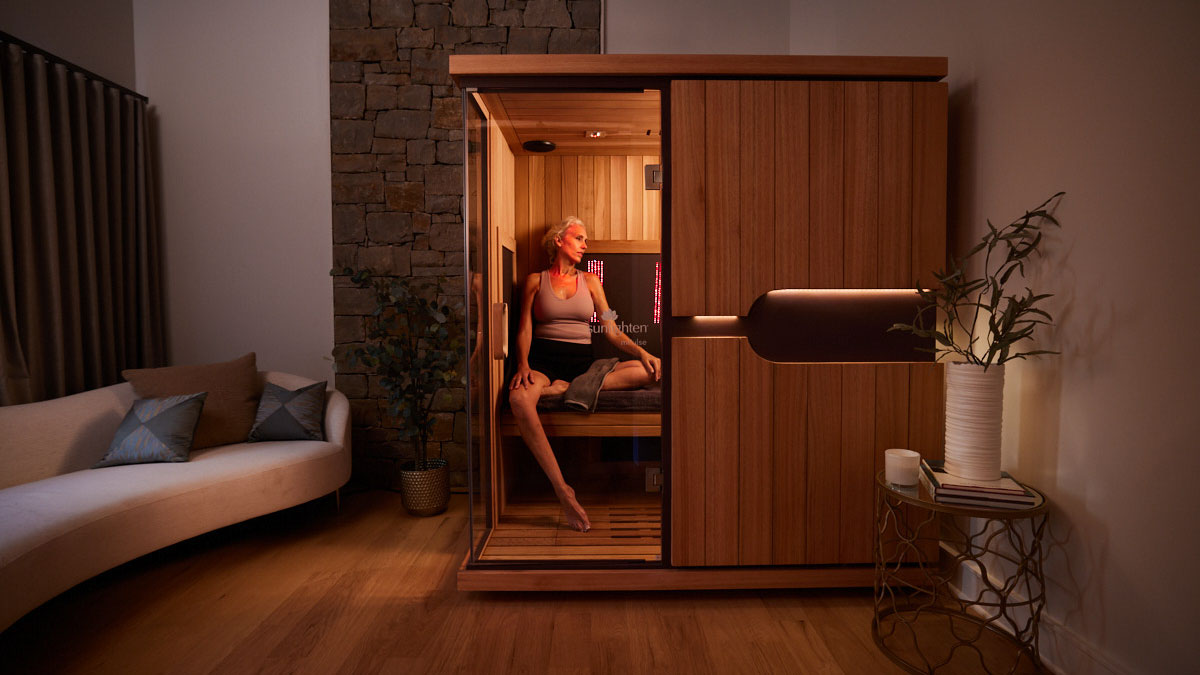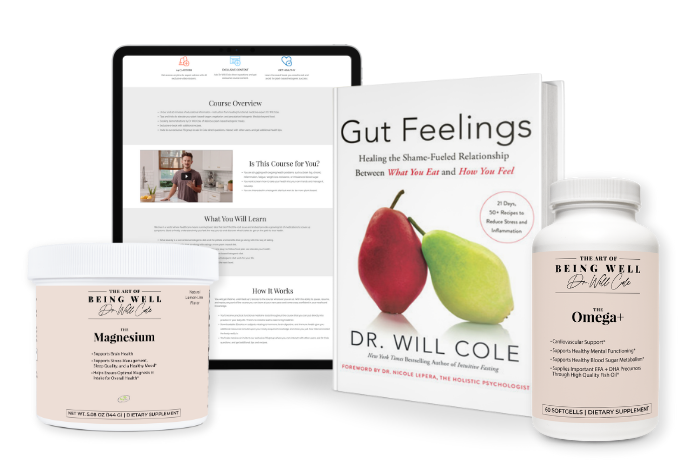Infrared Sauna: Do I Have To Sweat? + My Best Sauna Tips

If you follow me on Instagram, you know how much I love my infrared sauna. It’s a part of my everyday routines, and one of my top choices for biohacking tools.
A question I get a lot about saunas is, “Do I need to sweat to get the benefits of a sauna?” I get it; when you think of a sauna, you think of getting extremely hot and sweaty. But there’s more to it than elevated body temperatures, particularly when it comes to an infrared sauna. I thought I’d explain a little more for anyone wondering about this concern.
ARTICLE CONTINUES BELOW
Make Your Life a Cleanse
SUBSCRIBER-ONLY GUIDES FOR GUT HEALTH, VIBRANT ENERGY, HEALTHY FOOD & CLEAN ALCOHOL
Get FREE access to these + giveaways, recipes, & discount codes in personal emails from Dr. Will Cole.
Can You Detox Without Sweating?
You expect to sweat when you sit in a sauna. When you step out of a session, you might find you’re barely breaking a sweat, let alone that you’re drenched in it like you might have envisioned. It can happen even if the sauna is at a high heat setting. Is it still beneficial to you?
The answer is yes, absolutely!
Infrared Vs. Traditional Sauna
In an infrared sauna, it can take some time to sweat. Unlike in a traditional sauna, where the body responds to humidity and hot air, your body won’t sweat immediately in the infrared version.
Why?
The infrared wavelengths are absorbed into your body, raising your core body temperature from within. All the while, you’re breaking down toxins and inducing a sweat response, which takes time. That’s because of bio-individuality. The time it takes for you to sweat, and the amount you sweat, will vary depending on your body’s level of adaptation to heat.
Often, the sweat glands begin to excrete more during a session between 30 and 40 minutes. This creates a more enjoyable experience of a productive sweat, not just sitting in stifling-hot heat, feeling uncomfortable, and not getting the full benefits like an infrared sauna would provide.
The Dehydration Factor
If you find that you’re not sweating much at all despite having tried the infrared sauna a few times, then you might want to look at your water intake. Though most people know to get about half their body weight in ounces per day, you might need more if you are out in warmer temperatures, or if you exercise. Both of those will mean you need to add to your level of water intake.
To those concerned that dehydration may play a factor, I’d say this: try to increase your water intake a little, and see if it makes a difference in your body’s ability to sweat during a sauna session.
If you still aren’t sweating, then I would caution you that your sympathetic nervous system might be overactive, or you might have gene variants and other issues that can mean you have some nervous system dysfunction going on. It’s an issue I commonly see in my patients, and we work together to improve vagal nerve tone, and then they're able to begin to sweat again.
My Best Tips For A Great Sauna Session
If you’re interested in trying out an infrared sauna, I have some tips for you to get started and maximize your benefits.
1. Step It Up Little By Little
You’ll want to get your body accustomed to the infrared sauna, so start slowly. 10-15 minutes should do for your initial sessions, and only do so every other day. Gradually, keep increasing until you’re doing daily sessions of 40 minutes each in the optimal temperature range.
2. Listen To Your Unique Needs
Be sure to listen to your body, and be aware of whether you think it’s time to stop, reduce the temperature, or space your sessions out. Everyone’s needs are different, so continually check in with how you’re feeling. The symptoms that will warn you that you need to stop include nausea, fatigue, or anything that feels like the flu.
3. Find The Right Temperature
Your sauna should be preheated to 100°F. The optimal experience occurs between 100°F and 130°F. One reason I love my Sunlighten mPulse® 3 in 1® sauna is because it has a detoxification program that combines far- and mid-infrared. That means you start at a high intensity to increase your core temperature more quickly, and then reduce to a lower, comfortable level.
4. Dry Off And Keep The Benefits Going
Though most people would jump in a cold shower after a sauna, I don’t recommend that. Dry yourself off with a towel and continue to cool off naturally. That allows you to still burn calories and get the full benefits of your sauna session. It’s a good idea to drink a glass of cool water to make sure you hydrate properly, and then just continue on with your day.
Try Infrared Sauna At A Huge Discount
I get a lot of questions from people asking which type of sauna I recommend. The one I have in my home is the Sunlighten mPulse 3 in 1 sauna. Right now, they’re offering a significant discount if you purchase through my link and use the code DrWillCole at checkout.
Ready to get these benefits of infrared sauna, and more?
- Lower inflammation
- More energy
- Better detoxification
- Enhanced muscle recovery
- Pain relief
- Greater immunity
- And more,
Then you should definitely check out the discount Sunlighten is offering you. Learn more about their mPulse sauna today!
Start Your Health Journey Today
FUNCTIONAL MEDICINE CONSULTATIONS FOR PEOPLE AROUND THE WORLD
References:
- Facts & Statistics Anxiety and Depression Association of America https://adaa.org/about-adaa/press-room/facts-statistics
- Kassed CA, Herkenham M. NF-kappaB p50-deficient mice show reduced anxiety-like behaviors in tests of exploratory drive and anxiety. Behav Brain Res. 2004;154(2):577‐584. doi:10.1016/j.bbr.2004.03.026
- Crippa JA, Derenusson GN, Ferrari TB, et al. Neural basis of anxiolytic effects of cannabidiol (CBD) in generalized social anxiety disorder: a preliminary report. J Psychopharmacol. 2011;25(1):121‐130. doi:10.1177/0269881110379283
- Bergamaschi MM, Queiroz RH, Chagas MH, et al. Cannabidiol reduces the anxiety induced by simulated public speaking in treatment-naïve social phobia patients. Neuropsychopharmacology. 2011;36(6):1219‐1226. doi:10.1038/npp.2011.6
- Hill MN, Patel S. Translational evidence for the involvement of the endocannabinoid system in stress-related psychiatric illnesses. Biol Mood Anxiety Disord. 2013;3(1):19. Published 2013 Oct 22. doi:10.1186/2045-5380-3-19
View More At Our Store
Purchase personally curated supplements
and Dr. Will Cole’s books!

The information on this website has not been evaluated by the Food & Drug Administration or any other medical body. We do not aim to diagnose, treat, cure or prevent any illness or disease. Information is shared for educational purposes only. You must consult your doctor before acting on any content on this website, especially if you are pregnant, nursing, taking medication, or have a medical condition.
Our content may include products that have been independently chosen and recommended by Dr. Will Cole and our editors. If you purchase something mentioned in this article, we may earn a small commission.

BY DR. WILL COLE
Dr. Will Cole, DNM, IFMCP, DC is a leading functional medicine expert who consults people around the globe, starting one of the first functional medicine telehealth centers in the world. Named one of the top 50 functional and integrative doctors in the nation, Dr. Will Cole provides a functional medicine approach for thyroid issues, autoimmune conditions, hormonal imbalances, digestive disorders, and brain problems. He is also the host of the popular The Art of Being Well podcast and the New York Times bestselling author of Intuitive Fasting, Ketotarian, Gut Feelings, and The Inflammation Spectrum.

Gut Feelings
Healing The Shame-Fueled Relationship
Between What You Eat And How You Feel
